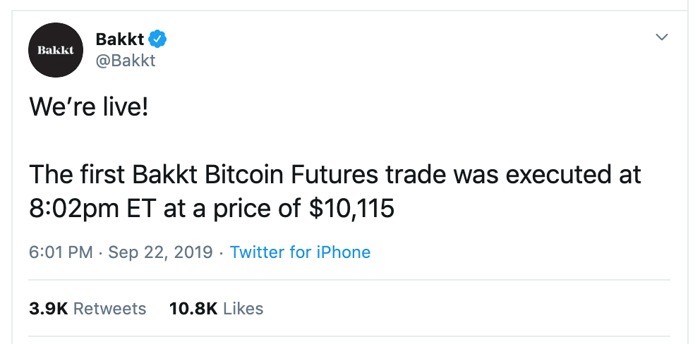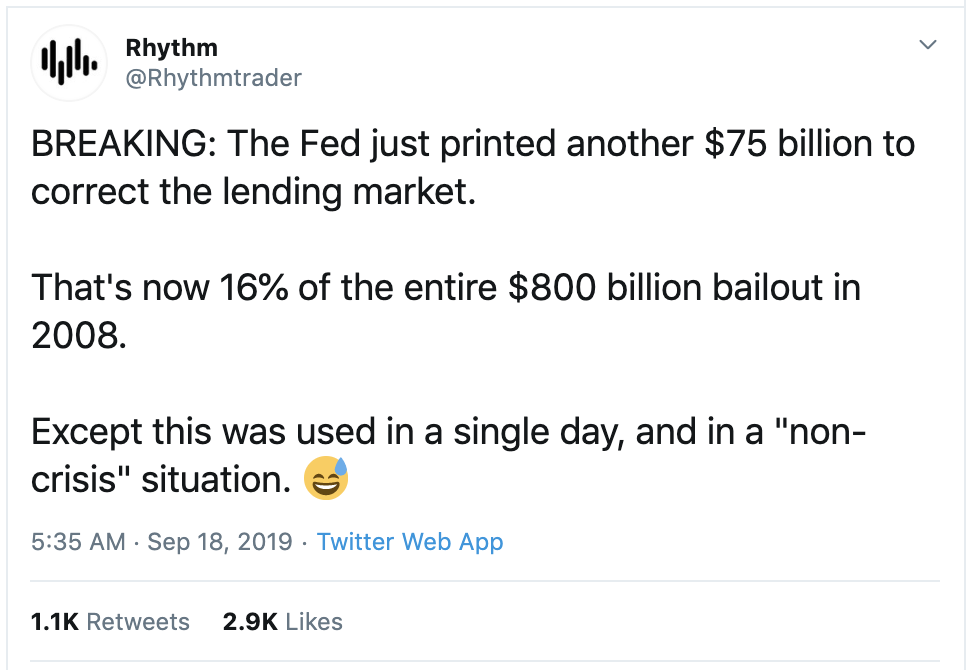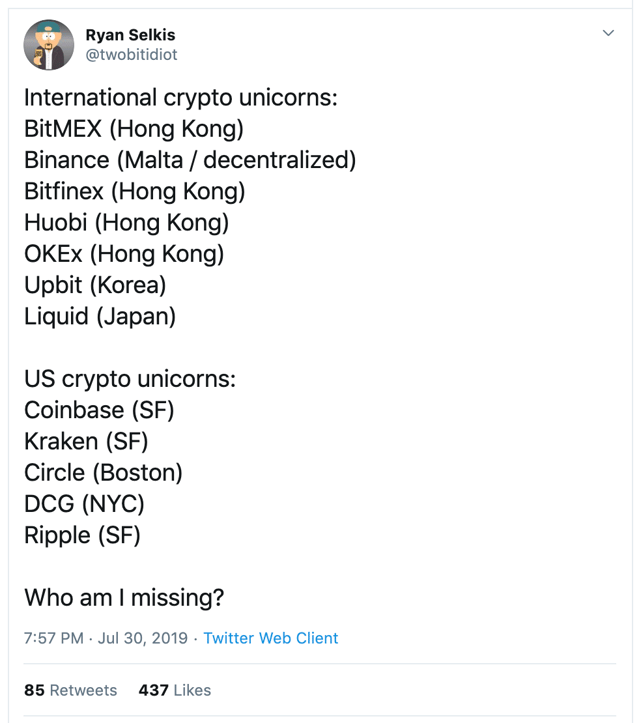What happened this week in the Crypto markets?
The “CCC”-rally
Crypto markets were mixed last week. Bitcoin was once again quiet, ultimately selling off 3%, but this was overshadowed by a relief rally from some of the worst-performing crypto digital assets over the past 18 months (with many risky assets rising double digits week-over-week). This move is reminiscent of the Corporate Debt markets when BBBs begin to outperform AAs, or CCCs outperform BBs, which is generally seen as a bullish reversal as investors search for higher beta and higher yields. This risk reversal was especially interesting since the exact opposite is happening in equities, with growth stocks getting destroyed versus value stocks, including a complete unwind and revaluation of hefty private company valuations (WeWork, Lyft, Uber, Blue Apron, etc). Over the past 18 months, crypto has often acted as a leading indicator for broader market “risk on / risk off” moves, so now that the Fed has once again cut rates and the economic data has become “less bad”, it will be interesting to see if equities once again follow crypto’s lead.
Bitcoin, meanwhile, continues to coil, with the crypto market growing impatient. The normally volatile asset has turned calm, with historical 30-day Bitcoin volatility falling to 2.05% from its July peak of 6.94%. This type of muted price action generally leads to a large and violent move one way or the other - we’ve already seen a 25% one day gain in April, and an 80% 3-week rally in June, so anything is on the table for the remainder of the year.
But the story this past week has nothing to do with Bitcoin.
Four Confusing Narratives Affecting Crypto - Repo, Trump, Bakkt, & Ethereum
1. Trump / Powell
We can't go a week without Trump laying into Fed Chairman Jerome Powell, with his most recent outburst calling for negative interest rates while simultaneously trashing Powell. While the Fed lowered rates by 25 bps as expected, Powell noted Wednesday that the central bank would engage in a sequence of cuts should conditions permit, but doesn't see that as necessary at this point in time. The Fed has been very transparent for the past decade -- but transparency and accuracy are two different things. Right now, that transparency is telling us to trust that the economy is fine, and that the Fed will be able to accurately pinpoint the exact level of intervention needed to keep it that way (thus far, 2 rate cuts). Continued rate cuts and further acts of QE are bullish for digital assets.
2. Repo Markets
I traded bonds for over a decade, and I still can’t figure out what just happened last week in the repo market. This may have simply been a cash flow timing issue that was alleviated by the Fed doing exactly what it is supposed to do to ensure healthy markets, or it could be the “June 2007 Bear Stearns HF” canary in the coal mine moment that preceded a financial meltdown 15 months later. So while we spent the week trying to figure out what happened just like most seasoned financial veterans, the better question to answer might be “Why do we accept things that we don’t understand as normal?” The financial markets have become so intertwined and confusing, that ignorance and acceptance have become standard. Meanwhile, we hear over and over that Bitcoin can’t work because it doesn’t make sense to have a non-government backed currency. If people don’t think Bitcoin will work because the governments would never allow it to work, one might ask, “if that’s true, is that better?” We’ve argued that it is time to question the status quo and traditional asset valuation narratives. The repo market is reminding us once again to start asking more questions.
What we do know for sure is that lending, especially short-term, is about trust in counterparties. And if that trust is breaking down, or if banks are starting to get nervous about lending to each other, it certainly isn’t great.
3. Bakkt Launch
Speaking of trust, while the future of digital assets is decentralization, right now, we’re nowhere near decentralization. Trusted counterparties are needed in this ecosystem to facilitate trading and payments of trustless, decentralized assets. While Coinbase, Kraken, Bitgo, Anchorage and a series of other VC-backed custody and Exchange solutions have grown tremendously, those with a fiduciary responsibility to clients care much more about a long history of trust than a short history of great technology. This is why Fidelity Digital Assets and Bakkt (owned by NYSE/ICE) are game-changers, as it allows traditional investors to finally gain comfort owning digital assets. While the futures product itself is not groundbreaking, Bakkt’s physically-settled futures offers a back-door way for large, risk-averse institutions to buy and custody bitcoin through an end-to-end regulated system approved by the CFTC and NYDFS, and backed by the sterling reputation of ICE. When compliance lawyers nod with approval, that’s good for Bitcoin and the rest of digital assets.

4. Ethereum
Away from Bitcoin, the price of Ether (ETH - the native currency of the Ethereum blockchain) has gained 20% vs BTC in September, clawing back from a year’s worth of underperformance and leading the “CCC rally” mentioned above. For those who already know and understand the complexities of the 2nd largest digital asset, the recent price rise makes sense. Ethereum has been growing in terms of importance, and recent metrics are quite bullish.
But this was Ethereum’s chance to separate from the pack, and prove that it too is a clear winner in the digital assets space just like Bitcoin. Unfortunately, Ethereum’s strength was ultimately swept aside as the rest of the “underperformers” rallied just as much or more than ETH.
So why isn’t Ethereum proving to be a worthy, stand-alone investment that isn’t tied to and correlated with the rest of digital assets? Quite frankly -- it’s just too confusing. This was by far the best explanation of Ethereum we’ve ever read, but it took 20 minutes to read and still leaves us somewhat uncertain on how ETH will capture value as Ethereum grows.
Crypto has created quite a few unicorns (companies with equity valuations greater than $1 billion). Ethereum is only 4 years old, and is not a company, but has arguably been the most successful of all with a market cap of $20 billion. But therein lies the issue from an investment standpoint. ETH is a great Venture Capital investment -- a bet with massive upside that works best when spread out over tens or hundreds of other similar bets on the future of decentralization and growth in Web 3.0 protocols. But many investors preferred to buy Facebook stock after it IPO’d and already had proven cash flows and market dominance, rather than bet on its future success 10 years earlier like Peter Thiel and a handful of other VCs. Ethereum today seems like a great VC investment - for the rest of the world, they seem to be taking a “wait and see” approach to ensure that Ethereum is the clear winner before investing.
Notable Movers and Shakers
As each week passes, Bitcoin continues to squeeze into an ever-tightening range. Price action this week, albeit negative (-3%), is generally inconclusive in market direction going forward considering the normal volatility Bitcoin is accustomed to. For the alternative digital assets, however, we saw both increased volatility and divergence among assets. In general, assets listed on US exchanges (ZRX, XLM, ETH, LINK, BAT, XRP, XTZ) outperformed those that are not (ATOM, MATIC, ENJ, ZIL) - this may be coincidence, or it may be a sign that liquidity (or the lack thereof) is a factor in w-o-w price movements. More specifically, Decentralized finance tokens (DeFi) were at the forefront of discussions:
- 0x (ZRX) rose 44% in anticipation of 0x protocol v3.0 being released by September 30th. This update aims to push multiple ZEIP’s (0x Improvement Proposals), as well as aiming to revisit the token mechanics of ZRX in the ecosystem. Nasdaq also revealed a decentralized finance index (DEFX) last week, which included ZRX among a basket of other digital assets.
- Ethereum (ETH) finished the week up 12% as public sentiment has started to shift in its favor. Network transaction fees have been on the rise, with a big proponent coming from Tether (USDT) moving from the Omni blockchain to Ethereum - as such, the developers at Ethereum have been conducting tests to improve network capacity and reduce on-chain bloating. Expansion due to necessity via market demand is a good sign for the de facto second largest digital asset, which has been largely out of favor since the market peak in Q4’17.
- Maker (MKR) announced that they would be integrating with Loom’s (LOOM) cross-chain gateway, enabling their decentralized stablecoin (DAI) to be utilized across various technical standards (ERC20, TRC20, BEP2, etc.) - this opens the possibility for DeFi applications to potentially be integrated into protocols other than Ethereums, which is currently seen as a net positive. As such, MKR (the direct beneficiary of an increased DAI economy) gained 14% last week.
What We’re Reading this Week
Wells Fargo announced last week it intends to launch an internal DLT settlement service, similar to JP Morgan’s JPM coin, called “Wells Fargo Digital Cash”. The payment rail will be used to decrease operational inefficiencies within the bank and will be used for cross-border payments for corporate clients. The project, expected to pilot next year, will be built on R3’s enterprise blockchain Corda. The bank was very careful to explain that this project is not a crypto currency or a stablecoin.
In a recent interview, SEC commissioner Hester Pierce - dubbed Crypto Mom by the digital asset community - shared her thoughts on regulation abroad, particularly in Asia. On a recent trip to Singapore she details how accepting and willing local regulators are to work with industry professionals to shape laws that make sense for digital assets. Additionally, she notes the entire region is laying the groundwork for digital assets to burgeon over the coming years. Her observations of crypto regulation abroad indicate that the US will not be the center of this new industry as it has yet to provide much regulatory clarity.
Last week Bitwise Asset Management published a presentation for the SEC, making the case for a publicly traded ETF. Bitwise cites three reasons for market maturation that can support an ETF: spot market efficiency, institutional grade custody and a growing derivatives market. Despite this, SEC chairman Jay Clayton has publicly commented that Bitcoin trading is not regulated enough for public markets. In related news, the CBOE withdrew its application for the VanEck SolidX ETF last week, weeks before its decision deadline in October.
Harbor is pivoting from helping companies with security token issuance to tokenizing existing securities. The first project is a $100m offering from four real estate funds, the tokenization of which will offer liquidity to the 1,100 investors that hold these shares. We expect to see the trend of tokenizing traditionally illiquid assets continue as blockchain technology develops.
And That’s Our Two Satoshis!
Thanks for reading everyone!
Questions or comments, just let us know.
The Arca Portfolio Management Team
Jeff Dorman, CFA - Chief Investment Officer
Katie Talati - Head of Research
Hassan Bassiri, CFA - PM / Analyst
Sasha Fleyshman - Trader
Wes Hansen - Head of Trading & Operations
To learn more or talk to us about investing in digital assets and cryptocurrency
.jpg)


